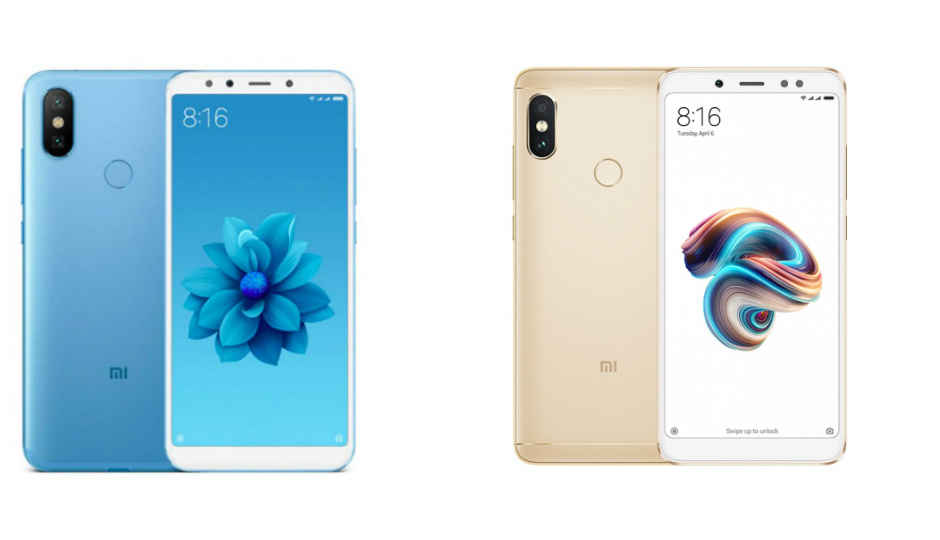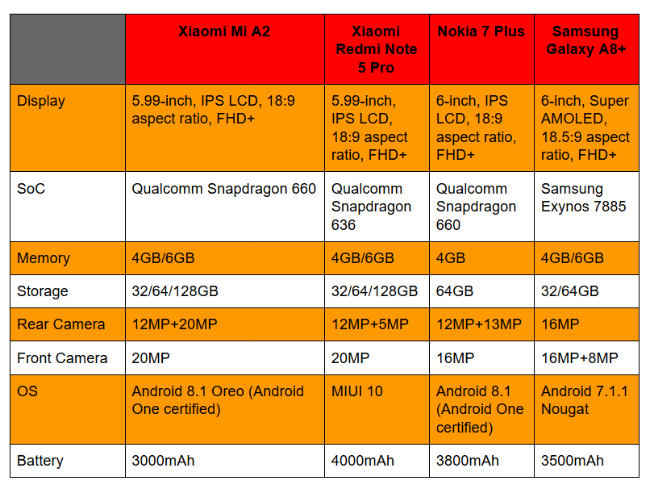Spec Comparison: Xiaomi Mi A2 vs Redmi Note 5 Pro
Xiaomi's second stock Android phone brings not just stock Android to the table, but also a more powerful processor. But is that enough to topple the Redmi Note 5 Pro?

The Xiaomi Mi A2 has been much anticipated after the success of the company’s first stock Android phone in India. Well, it finally launched in Europe on Tuesday and India will see the phone on August 8th. The Mi A2 is a rebranded Mi 6X with stock Android on top, just like how the Mi A1 was the rebranded Mi 5X. The Mi A2 is Android One certified which means it will be receiving regular security updates and the Android P update soon as it’s made available on the Pixel phones. It’s most obvious competition will be Xiaomi’s own best-selling device — The Redmi Note 5 Pro. If you are in the market for a new phone and you can’t go beyond the mid-range segment, the Note 5 Pro is the obvious choice. But with the Mi A2, the choice becomes only more difficult. So, let’s find out whether the Mi A2 is a better phone than the Note 5 Pro based on the hardware and features it brings to the table.
 Survey
SurveyDesign and build
Both the Xiaomi Mi A2 and the Xiaomi Note 5 Pro have a similar design. It’s the usual Xiaomi design with a brushed aluminium body and the 18:9 display with big bezels on the top and the bottom. The bezels thin down along the sides making the display the centre of attention. One the back, both have vertically aligned dual camera units and a fingerprint sensor. The back of both the phones are curved gently around the edges for a good grip. Measuring 7.3mm the Mi A2 is a lot slimmer than the Note 5 Pro which is 8.1mm thick, despite packing almost a similarly capacious battery inside. The antenna lines of the Mi A2 is designed a little differently from the Note 5 Pro, but apart from that, there’s not much between the designs of the two phones.
Display
Again, the display on the Mi A2 and the Redmi Note 5 Pro are more or less similar. Both have a 5.99-inch panel that takes up around 77.3 percent of the body. Both the displays have an 18:9 aspect ratio and FHD+ resolution that pegs the pixel density at roughly 403ppi. On paper, the displays on the two phones are pretty standard for the mid-range segment which isn’t a bad thing. However, despite cutting down on the width of the display of the Note 5 Pro, it’s still difficult to use with one hand. Being of same size, the issue could carry over the Mi A2 as well.
Under the hood
This is where the Mi A2 proves its mettle. The A2 is powered by the Qualcomm Snapdragon 660 SoC which is more powerful than the Snapdragon 636 that powers the Redmi Note 5 Pro. Both phones have up to 6GB RAM and 128GB storage. The Snapdragon 660 SoC has an octa-core setup with four custom Kryo 260 cores clocked at 2.2Ghz and another four Kryo 260 clocked at 1.8GHz. The Snapdragon 636 SoC also has an octa-core setup with custom Kryo 260 cores but the maximum clock speed goes only up to 1.8GHz. While there shouldn’t be a significant boost in the performance, having a lower clock speed in the efficiency cluster could help in consuming less power. Both phones have expandable storage up to 256GB availed via the second SIM slot. There’s also the IR blaster that’s now a standard in Xiaomi phones.
Software
This is the biggest factor differentiating the two phones. The Mi A2 runs on pure, stock Android Oreo under the Android One program. The Note 5 Pro is powered by Xiaomi’s own MIUI 8.5 which can be upgraded to the latest MIUI 10. The two are as different as chalk and cheese. Stock Android is what Google imagined Android should be. It’s lightweight, easy to use and is visually appealing and minimalist at the same time. MIUI 10 is quite heavy in terms of animations and features, but that doesn’t mean it’s slow and laggy. Xiaomi’s own UI is also quite slick and smooth and offers unique, thoughtful features like converting SMS-based tickets into a more visually appealing version, automatically copying OTP, a suite of MIUI apps including Mi Drop that allows users to share files between two phones without the internet. Furthermore, being under the Android One program, the Mi A2 will receive regular security updates and a promised upgrade to Android P.
Camera
Both the Redmi Note 5 Pro and the Mi A2 tout dual cameras at the back. But the one on the Mi A2 has been improved, at least on paper. The Mi A2 has a 12-megapixel primary sensor with f/1.8 aperture and 1.25um pixel pitch while the secondary 20-megapixel sensor also has f/1.8 aperture and 1.0um pixel pitch. On the other hand, the Redmi Note 5 Pro’s primary 12-megapixel sensor has an f/2.2 aperture with 1.25um pixel size and a secondary 5-megapixel sensor with 1.12um sensor. The secondary sensor, in both cases, is used for the portrait mode. Up front, both phones have a 20-megapixel sensor with f/2.2 aperture. Xiaomi claims to have trained the cameras on both the phones to recognise the beauty spots of people’s faces while taking selfies so as to enhance the details.
Battery
The Mi A2 has a 3,000mAh battery while the Redmi Note 5 Pro has a 4,000mAh battery. That’s a lot of difference between the two. The Note 5 Pro manages to last well over a day. It remains to be seen how long the Mi A2 lasts, although the Snapdragon 660 SoC should reduce power consumption and improve the battery life of the phone.
In conclusion
Going through the specs, it’s clear that the Mi A2 comes out as a more powerful device than the Redmi Note 5 Pro, at least on paper. That doesn’t take anything away from the Note 5 Pro though. The performance of the Mi A2 will definitely be higher than the Note 5 Pro because the processor is simply more powerful. The phone’s software will also be factor in determining the Mi A2's overall performance. Xiaomi’s penchant for making good hardware combined with the simplicity of stock Android is simply too lucrative a deal to pass on. However, MIUI-based devices have carved a name out for itself as well and being the number one smartphone brand in the country, users are certainly familiar with the interface of MIUI. In the end, hence, it all comes down to the UI you prefer.
